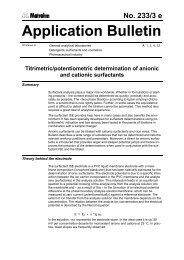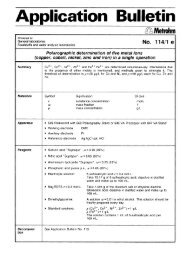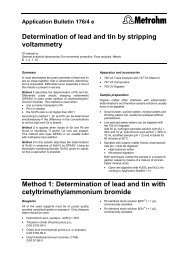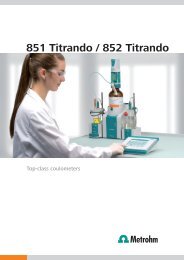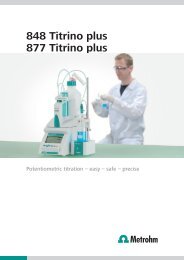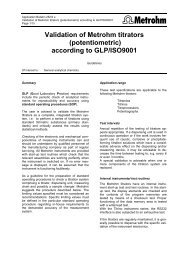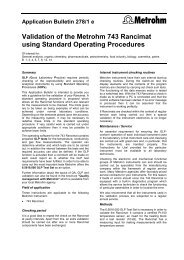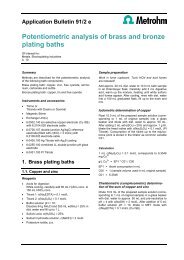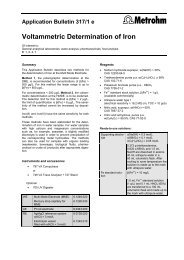Titer determination in potentiometry - Metrohm
Titer determination in potentiometry - Metrohm
Titer determination in potentiometry - Metrohm
Create successful ePaper yourself
Turn your PDF publications into a flip-book with our unique Google optimized e-Paper software.
Application Bullet<strong>in</strong> 206/4 e<strong>Titer</strong> <strong>determ<strong>in</strong>ation</strong> <strong>in</strong> <strong>potentiometry</strong>Of <strong>in</strong>terest to:General analytical laboratoriesA L 1SummaryThis Bullet<strong>in</strong> provides an overview of the potentiometrictiter <strong>determ<strong>in</strong>ation</strong> <strong>in</strong> common volumetric solutions.Many publications only describe methods with color<strong>in</strong>dicators. However, the titration conditions chosen forthe titer <strong>determ<strong>in</strong>ation</strong> should resemble those used forthe actual analysis as closely as possible.The tables below conta<strong>in</strong> suitable titrimetric standardsubstances and electrodes for selected titrants as wellas additional <strong>in</strong>formation. Follow<strong>in</strong>g this, a procedurefor titer <strong>determ<strong>in</strong>ation</strong>s is described.Instruments and accessoriesVarious <strong>in</strong>struments or comb<strong>in</strong>ations of <strong>in</strong>strumentscan be used:• pH meter und Dosimat for manual titrations• Titrando, Titr<strong>in</strong>o or Titroprocessor with Dosimats orDos<strong>in</strong>os for automatic record<strong>in</strong>g and evaluation ofthe titration curves and calculation of the results• Titrators as listed above, comb<strong>in</strong>ed with a samplechangerThe <strong>in</strong>struments for automatic titrations offer the possibilityof transmitt<strong>in</strong>g the data to a PC us<strong>in</strong>g the VESUVor TiNet Metrodata software.Titrimetric standard substancesTitrimetric standard substances have the follow<strong>in</strong>gcharacteristic features: Their content rema<strong>in</strong>s virtuallyunchanged, they have a def<strong>in</strong>ed, high degree of purity,they can be dried and they can be directly traced backto standard reference materials (e.g. from NIST =National Institute of Standards and Technology, USA).Some examples of such recommended titrimetric standardsubstances or secondary standards are:• Fluka No. 11099, arsenic trioxide• Merck No. 102400, potassium hydrogen phthalate• Fluka No. 60357, potassium hydrogen phthalate• Merck No. 102408, tris(hydroxymethyl)-am<strong>in</strong>omethane• Fluka No. 93440, tris(hydroxymethyl)-am<strong>in</strong>omethane• Merck No. 102406, sodium chloride• Fluka No. 71387, sodium chloride• Merck No. 102407, sodium oxalate• Fluka No. 71804, sodium oxalate• Fluka No. 60350, potassium hydrogen diiodate• Merck No. 102403, potassium dichromate• Merck No. 102401, benzoic acid• Fluka No. 21067, calcium carbonate• Riedel-de Haën No. 34849, HYDRANAL WaterStandard• Riedel-de Haën No. 34803, sodium tartrate dihydrateRemarksThe weight of titrimetric standard substance dependson the concentration of the titrant and the buret volumeused.For accuracy reasons, the sample weight must not betoo small. A sample weight >100 mg normally yieldsgood analytical results. However, the m<strong>in</strong>imum weightvaries considerably, depend<strong>in</strong>g on the substance, thebalance used and the required accuracy.In order to <strong>in</strong>crease the measur<strong>in</strong>g accuracy, it may bea good idea to prepare a stock solution <strong>in</strong>stead ofweigh<strong>in</strong>g the titrimetric standard substance directly <strong>in</strong>tothe titration vessel.Literature• G. Jander, K. F. JahrMassanalyse, Theorie und Praxis der Titrationenmit chemischen und physikalischen IndikationenWalter de Gruyter & Co., 2003ISBN 3-11-017098-1• <strong>Metrohm</strong> Monograph No. 8.015.5003Electrodes <strong>in</strong> <strong>potentiometry</strong><strong>Metrohm</strong> Ltd., 2001• <strong>Metrohm</strong> Monograph No. 8.016.5003Practical aspects of modern titration<strong>Metrohm</strong> Ltd., 2001• Various <strong>Metrohm</strong> Application Bullet<strong>in</strong>s• LaborpraxisBirkhäuser, 1996ISBN 3-7643-2528-3• Merck «Spektrum», Sonderheft Titration und Elektrochemie• HYDRANAL-Praktikum, Wasserreagenzien nachEugen Scholz für die Karl-Fischer-TitrationRiedel-de Haën AG, 1996
Application Bullet<strong>in</strong> 206/4 e<strong>Titer</strong> <strong>determ<strong>in</strong>ation</strong> <strong>in</strong> <strong>potentiometry</strong>Page 2/4Electrodes and titrimetric standard substances for determ<strong>in</strong><strong>in</strong>gthe titer of different titrantsTable 1: Acid-base titrations (acidimetry, alkalimetry)Complexometric/chelatometric titrationsTitrant Titrimetric standard Electrode RemarksAqueous acidsHCl, H 2 SO 4Aqueous basesNaOHPerchloric acid HClO 4<strong>in</strong> glacial acetic acidTrifluoromethanesulfonicacid CF 3 SO 3 H<strong>in</strong> glacial acetic acidTrifluoromethanesulfonicacid CF 3 SO 3 H<strong>in</strong> isopropanolTetrabutylammoniumhydroxide <strong>in</strong> isopropanolAlcoholic KOHCyclohexylam<strong>in</strong>eC 6 H 11 NH 2 <strong>in</strong> methanolEDTA (Komplexon III,Titriplex III or IdranalIII)Tris(hydroxymethyl)-am<strong>in</strong>omethane(CH 2 OH) 3 CNH 2 (TRIS)(105 °C)Potassium hydrogenphthalate C 8 H 5 KO 4(105 °C)Potassium hydrogenphthalate C 8 H 5 KO 4 orTRIS(105 °C)Potassium hydrogenphthalate C 8 H 5 KO 4 orTRIS(105 °C)Potassium hydrogenphthalate C 8 H 5 KO 4 orTRIS(105 °C)Benzoic acidC 6 H 5 COOHBenzoic acidC 6 H 5 COOHBenzoic acidC 6 H 5 COOHCalcium carbonateCaCO 3(105 °C)Comb<strong>in</strong>ed pH electrode,e.g. 6.0259.100Comb<strong>in</strong>ed pH electrode,e.g. 6.0259.100Solvent: waterSolvent: water6.0229.100 Solvotrode Solvent: glacial acetic acidReference electrolyte: c(LiCl) = 2 mol/L<strong>in</strong> ethanol (6.2312.010)6.0229.100 Solvotrode Solvent: glacial acetic acidReference electrolyte: c(LiCl) = 2 mol/L<strong>in</strong> ethanol (6.2312.010)6.0229.100 Solvotrode Solvent: glacial acetic acidReference electrolyte: c(LiCl) = 2 mol/L<strong>in</strong> ethanol (6.2312.010)6.0229.100 Solvotrode Solvent: isopropanolReference electrolyte: c(TEABr) =0.4 mol/L <strong>in</strong> ethylene glycol(6.2320.000)6.0229.100 Solvotrode Solvent: ethanolReference electrolyte: c(TEABr) =0.4 mol/L <strong>in</strong> ethylene glycol(6.2320.000)6.0229.100 Solvotrode Solvent: methanolReference electrolyte: c(TEABr) =0.4 mol/L <strong>in</strong> ethylene glycol(6.2320.000)6.0504.100 calcium ISEor6.0502.140 copper ISE;6.0726.107 referenceelectrode (filled withc(KCl) = 3 mol/L)Suspend CaCO 3 <strong>in</strong> water, dissolve <strong>in</strong>HCl and add buffer pH = 10.0(NH 3 /NH 4 OH).For titrations with the Cu ISE, add1 mL c(Cu-EDTA) = 0.05 mol/L to thesample solution (see also <strong>Metrohm</strong> ABNo. 101).The <strong>in</strong>dicated electrodes are meant as a suggestion. It is often also possible to use other electrodes or electrodesystems.
Application Bullet<strong>in</strong> 206/4 e<strong>Titer</strong> <strong>determ<strong>in</strong>ation</strong> <strong>in</strong> <strong>potentiometry</strong>Page 3/4Table. 2:Precipitation titrations (argentometry)Redox titrations (cerimetry, iodometry, permanganometry, ferrometry, Karl Fischer titration)Titrant Titrimetric standard Electrode RemarksSilver nitrate AgNO 3Lanthanum nitrateLa(NO 3 ) 3Cerium(IV) <strong>in</strong> H 2 SO 4 orHClO 4Sodium chloride NaCl(110 °C)Sodium fluoride NaF(110 °C)Arsenic trioxide As 2 O 3(105 °C)Iod<strong>in</strong>e solution KI 3 Arsenic trioxide As 2 O 3(105 °C)Potassium permanganateKMnO 4Sodium thiosulfateNa 2 S 2 O 3Iron(II) solution(NH 4 ) 2 Fe(SO 4 ) 2Sodium oxalateNa 2 C 2 O 4(105 °C)Potassium hydrogendiiodate KH(IO 3 ) 2(100 °C)Potassium dichromateK 2 Cr 2 O 7(105 °C)6.0450.100 comb<strong>in</strong>edAg r<strong>in</strong>g electrode (referenceelectrolyte: KNO 3saturated) or6.0430.100 Ag Titrode6.0502.150 fluoride ISE;6.0726.107 referenceelectrode (filled withc(KCl) = 3 mol/L)6.0451.100 comb<strong>in</strong>ed Ptr<strong>in</strong>g electrode or6.0431.100 Pt Titrode6.0451.100 comb<strong>in</strong>ed Ptr<strong>in</strong>g electrode or6.0431.100 Pt Titrode6.0451.100 comb<strong>in</strong>ed Ptr<strong>in</strong>g electrode or6.0452.100 comb<strong>in</strong>edAu r<strong>in</strong>g electrode6.0451.100 comb<strong>in</strong>ed Ptr<strong>in</strong>g electrode or6.0431.100 Pt Titrode6.0452.100 comb<strong>in</strong>edAu r<strong>in</strong>g electrodeSodium nitrite NaNO 2 Sulfanilic acid 6.0452.100 comb<strong>in</strong>edAu r<strong>in</strong>g electrodeKarl Fischer reagentSodium tartrate dihydrateC 4 H 4 Na 2 O 6 x2 H 2 O orwater standards <strong>in</strong>ampoules (Riedel-deHaën)6.0338.100 polarizeddouble Pt electrodeDissolve NaCl <strong>in</strong> 40 mL water, thenadd 2 mL c(HNO 3 ) = 2 mol/L and possibly2 mL 0.2% polyv<strong>in</strong>yl alcohol solution.(Dissolve polyv<strong>in</strong>yl alcohol (Merck No.114266) <strong>in</strong> warm water.)Dissolve NaF <strong>in</strong> 50 mL water, add10 mL acetate buffer pH = 6.0 andtitrate slowly (see also <strong>Metrohm</strong> ABNo. 82).Dissolve As 2 O 3 <strong>in</strong> 10 mL c(NaOH) =1 mol/L, then add 6 mL c(H 2 SO 4 ) =1 mol/L and 2 g NaHCO 3 (see also<strong>Metrohm</strong> AB No. 52).Dissolve As 2 O 3 <strong>in</strong> 10 mL c(NaOH) =1 mol/L, then add 6 mL c(H 2 SO 4 ) =1 mol/L and 2 g NaHCO 3 .Dissolve Na 2 C 2 O 4 <strong>in</strong> 40 mL water, thenadd 5 mL concentrated H 2 SO 4 and 1 gMnSO 4 .Stock solution: Dissolve KH(IO 3 ) 2 <strong>in</strong>water and make up to 100 mL; use10 mL of this solution, dilute with40 mL water, then add 1 g KI and 4 mLc(HCl) = 1 mol/L.Dissolve K 2 Cr 2 O 7 <strong>in</strong> 40 mL water, thenadd 3 mL concentrated H 2 SO 4 .Dissolve sulfanilic acid <strong>in</strong> 50 mL water,add 30 mL w(HBr) = 20% and titrateimmediately us<strong>in</strong>g the MET mode(0.10 mL, 25 s).Fill methanol or KF solvent <strong>in</strong>to thetitration vessel and condition. As soonas a steady drift is atta<strong>in</strong>ed, add thestandard and titrate with the KF reagent.The titer is specified <strong>in</strong> mg H 2 O / mLKF reagent (documentation availablefrom Riedel-de Haën or Merck).The <strong>in</strong>dicated electrodes are meant as a suggestion. It is often also possible to use other electrodes or electrodesystems.
Application Bullet<strong>in</strong> 206/4 e<strong>Titer</strong> <strong>determ<strong>in</strong>ation</strong> <strong>in</strong> <strong>potentiometry</strong>Page 4/4Example of a procedure for titer <strong>determ<strong>in</strong>ation</strong>s us<strong>in</strong>g the799 GPT Titr<strong>in</strong>oSummaryDeterm<strong>in</strong>ation of the titer of c(HCl) = 0.1 mol/L us<strong>in</strong>gthe 799 GPT Titr<strong>in</strong>o.The titration is carried out <strong>in</strong> the DET or MET mode.Tris(hydroxymethyl)-am<strong>in</strong>omethane is used as titrimetricstandard substance.Instruments and accessories• 799 GPT Titr<strong>in</strong>o• 2.728.0040 Magnetic Stirrer• 6.3026.220 Exchange Unit 20 mL• 6.0259.100 Unitrode (reference electrolyte: c(KCl)= 3 mol/L)• 6.2104.020 electrode cableReagents• Tris(hydroxymethyl)-am<strong>in</strong>omethane (TRIS) (titrimetricstandard substance), Merck No. 102408 orFluka No. 93440• Distilled water (free from carbonate)AnalysisThe TRIS is dried <strong>in</strong> a flat bowl for 2 h at 105 °C, thenallowed to cool down <strong>in</strong> a desiccator and stored there.Us<strong>in</strong>g an analytical balance, approx. 0.15 g of the driedTRIS is weighed exactly <strong>in</strong>to a 100 mL beaker. Afteraddition of 40 mL carbonate-free water, the solution isstirred until the titrimetric standard substance hasdissolved, then titration is performed us<strong>in</strong>g the follow<strong>in</strong>gparameters:Parameters MET:Titration parametersV step0.10 mLdos.ratemax. mL/m<strong>in</strong>signal drift50 mV/m<strong>in</strong>start V:rel.faktor 50Stop conditionsstop V:rel.stop V 120Calculation<strong>Titer</strong> = C00 / (C01 * C02 * EP1)C00 = weight of TRIS <strong>in</strong> mgC01 = 121.14 (molar mass of TRIS <strong>in</strong> g/mol)C02 = 0.1 (concentration of the titrant <strong>in</strong> mol/L)EP1 = titrant consumption <strong>in</strong> mLRemarksThe titer <strong>determ<strong>in</strong>ation</strong> is carried out five times.Us<strong>in</strong>g the Titr<strong>in</strong>o’s statistics function, the mean valueas well as the absolute and relative standard deviationcan be calculated.The mean value can be automatically stored as commonvariable (C3X). This makes it possible to directlyuse the current titer <strong>in</strong> other titration methods.Parameters DET:Titration parametersmeas.pt.density 4m<strong>in</strong>.<strong>in</strong>cr. 10.0 µLsignal drift50 mV/m<strong>in</strong>start V:rel.faktor 50Stop conditionsstop V:rel.stop V 120





